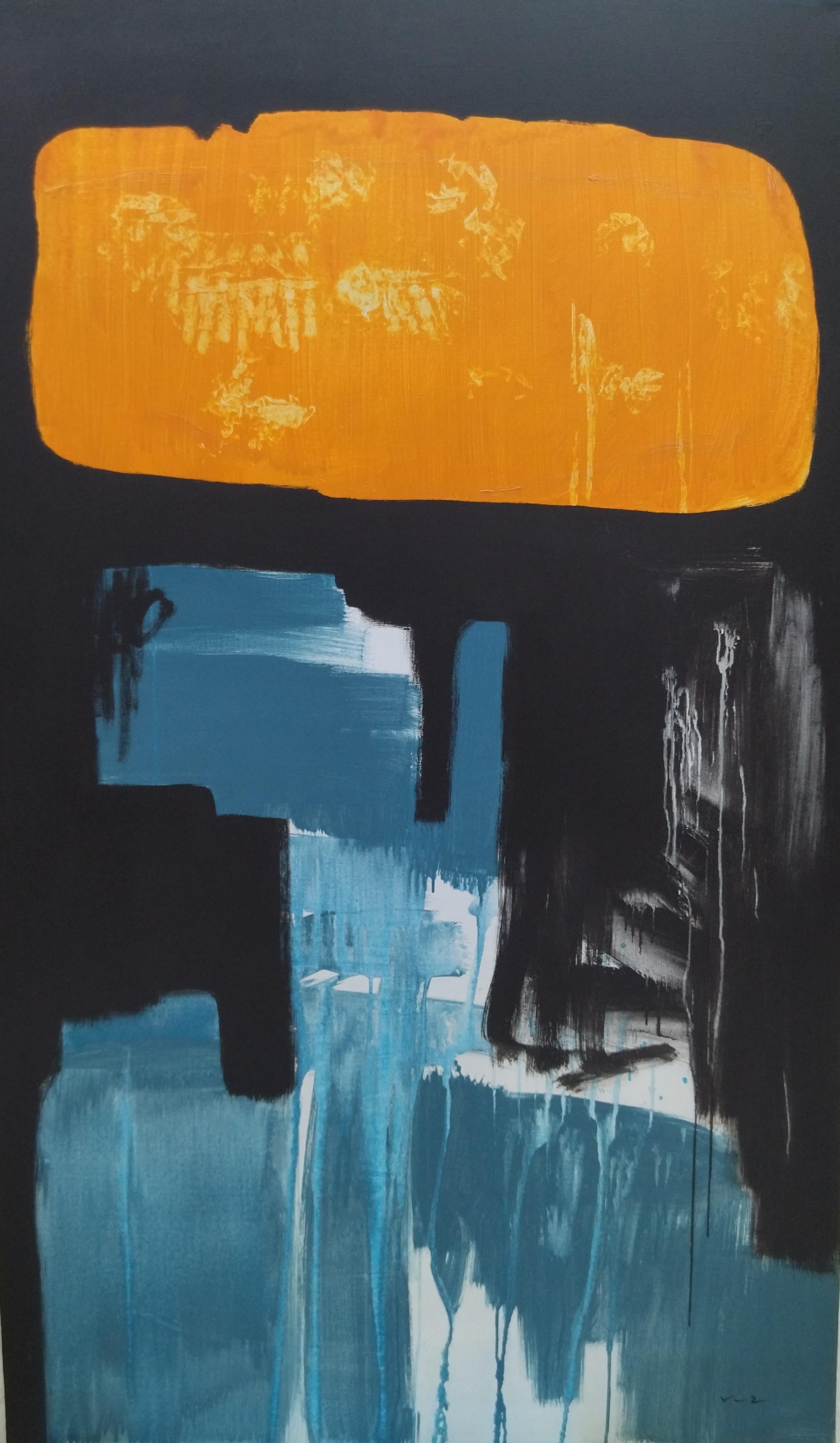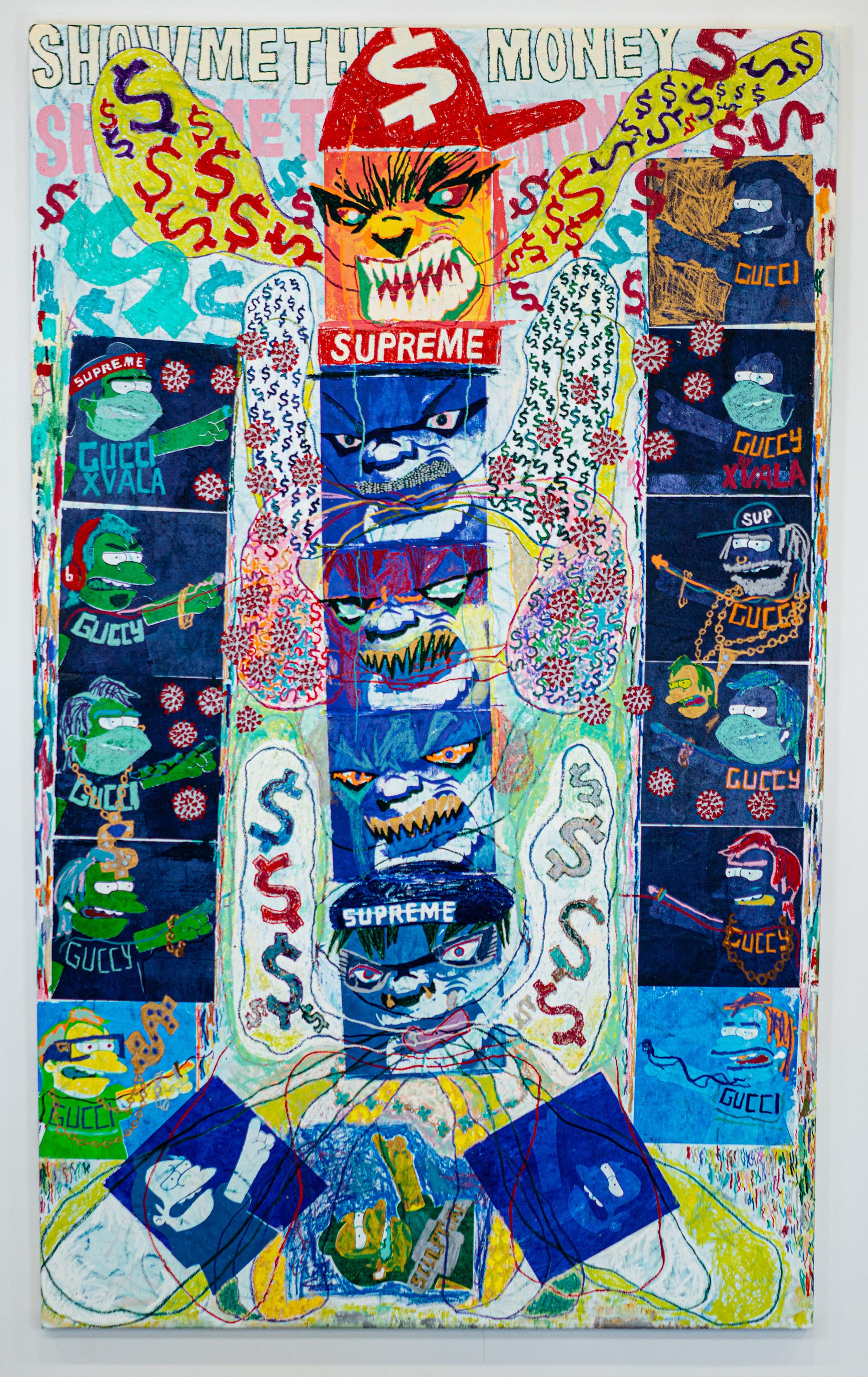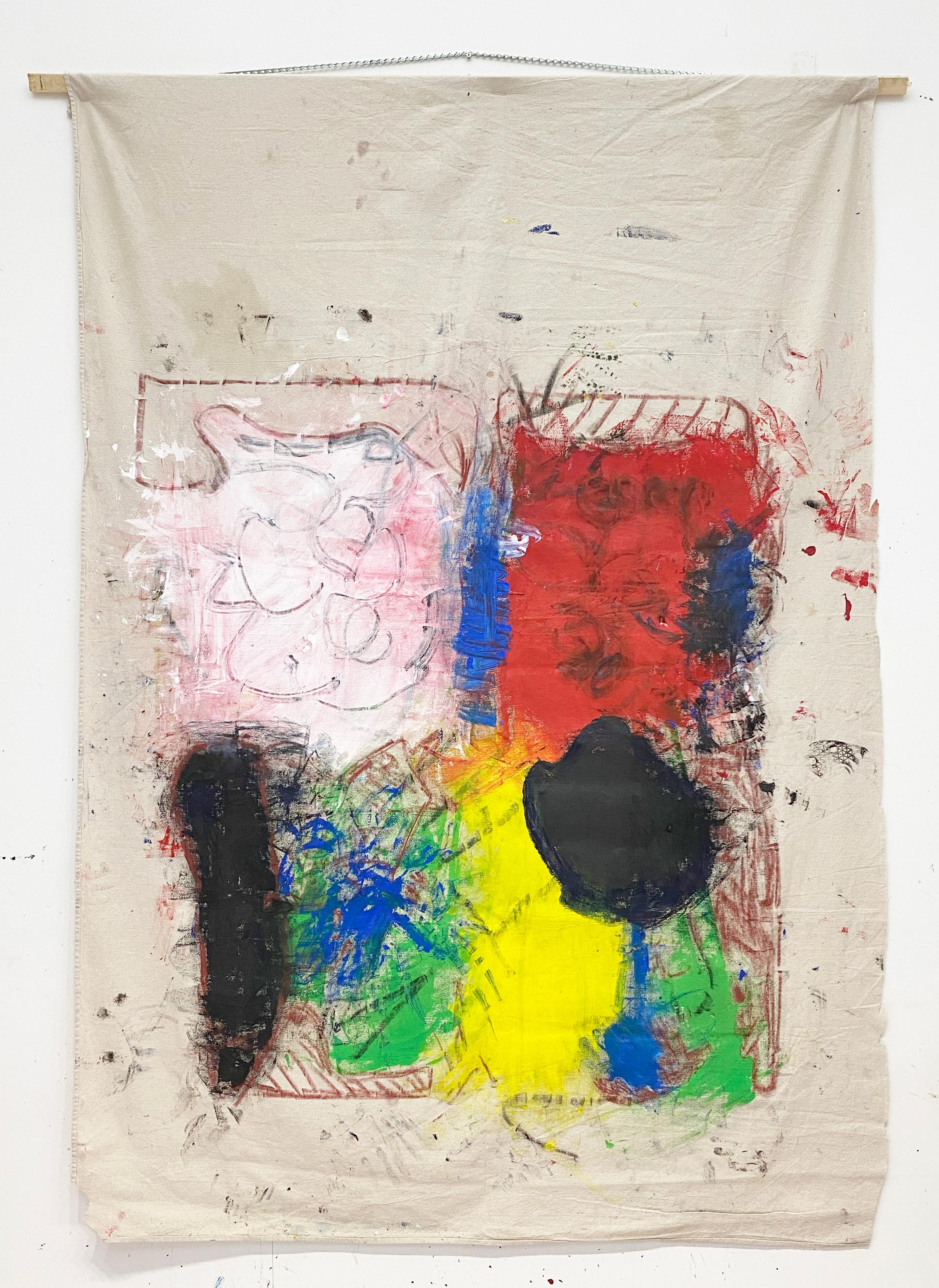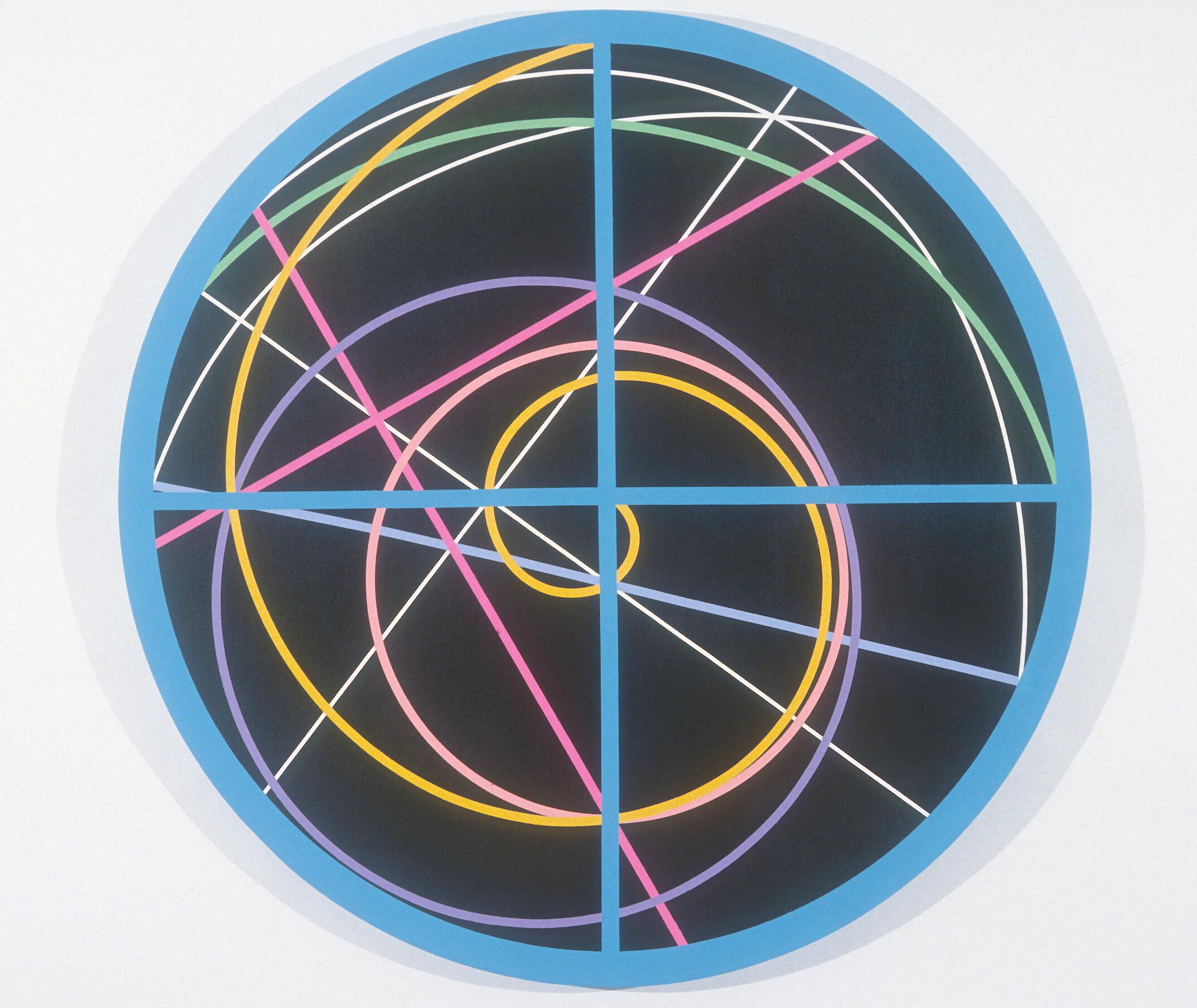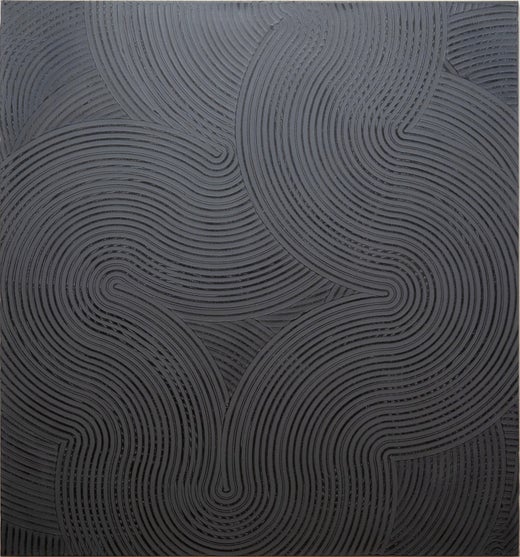Objekte ähnlich wie Geometrisches abstraktes Ölgemälde Duanye Hatchett Original Modernistisches frühes Werk
Möchten Sie mehr Bilder oder Videos?
Zusätzliche Bilder oder Videos von dem*der Anbieter*in anfordern
Duanye HatchettGeometrisches abstraktes Ölgemälde Duanye Hatchett Original Modernistisches frühes Werk1994
1994
Angaben zum Objekt
An abstract painting by Duayne Hatchett from his Trowel Painting Series. Oil on canvas, circa 1990. Unterschrieben. Gerahmt.
Duayne Hatchett was a visual artist whose work included prints, paintings, sculpture, and found objects. He was born on May 12, 1925 in Shawnee, Oklahoma. He enlisted in the Air Force where he trained to become a fighter pilot. After leaving the militrary he studied design at the University of Oklahoma. His highly technical military training combined a mathematical intelligence with a love for physics and a daring embrace of new experience, all of which would soon be the tools for his evolution through art.
Two major influences interacted on his early development at OU. Emelio Omero, a colleague and close friend of Diego Rivera, introduced him to the revolutionary art ideas of Mexico City, while teaching him a wide range of printing techniques that would culminate in a Masters Degree in Painting in 1952. During this time he met Bruce Goff, a renowned Wright disciple, who was teaching architecture at OU and befriended Hatchett, introducing him to the most avant-garde architecture of that time.
He spent his summers while at OU designing for a small sign shop, which introduced him to new materials used for building neon, plastic, and metal signs. The use of new materials and a keen sense for design would soon become invaluable building blocks for future sculpture. During this time he met and married Mary Ellen Jeffries. They would spend their lives together and raise three children, David (me), my brother Dana, and my sister Jeffri. As children, they were immersed in art from childhood and benefited greatly from this loving art and domestic environment.
Hatchett was always interested in the techniques of construction, often watching different tradesmen working, understanding how materials are put together to create the manmade environment that surrounded him. While teaching printmaking at Oklahoma City University from 1951 through ‘54, he began to build sculpture employing some of the materials and techniques that he saw workers using. He was beginning to draw the attention of architects and he became interested in their work-trade processes, moving from blue prints to construction. He accepted an invitation from Alexander Hogue to teach sculpture at Tulsa University in 1954. He moved his family to Tulsa where he would teach for the next ten years.
While in Tulsa, he became well known as a teacher and a sculptor, often lecturing at various sculpture conferences around the country. He also began to obtain commissions for sculpture as his interaction with architecture continued to evolve. He began to meet and interact with some of the most influential New York artists, including David Smith, Louise Nevelson, Noguchi, and Chicago artist, Richard Hunt.
The 'found object' became important subject matter for many artists including Hatchett and his frequent trips to junkyards yielded the materials for welded sculptures that explored abstract forms suggestive of the world around him. Sources of inspiration ranged from a dead cat smashed on the road to Sputnik orbiting the earth. Alan Stone Gallery in New York City, arranged to show two of these pieces at the Museum of Modern Art in 1963.
He was offered a teaching job at Ohio State University in 1964, where he would teach sculpture for the next three years, and make a leap of imagination that would propel his art into the museums and galleries in New York City and beyond. He began by moving away from combining found objects to using found materials to fabricate objects that he called "Totems." Royal Marks Gallery in New York City began to represent Hatchett in 1964 and arranged for him to be included in the ‘Young American Sculpture East to West’ show representing the United States in the 1964 New York World’s Fair. He would then leave any hint of the found object or junk material behind (until the 90’s) and move into pure abstraction, what can only be described as 'Modern' Art.
Taking his cue from modern architecture, he began to draw simplified volumes and planes, minimally rendered, so as to be easily grasped as a whole. Built with industrial materials, sheet metals and plastics, the images suggested the look of modern technology and architectural accuracy in the environment. These new works resulted in multiple one-person shows, including shows at Royal Marks Gallery in 1965, ’68, ’69, and ’70, and defined a major shift in his work that would be played out for the next two decades. He was featured on the cover of the Whitney Annual and the Whitney Museum acquired a large sculpture in 1967. He was included in the American Sculpture of the Sixties show at the Los Angeles County Museum and the Pittsburgh International, at the Carnegie Institute Museum of Art that same year.
In 1968 he took a teaching position at the University of Buffalo where he would head the sculpture department for the next 24 years and he would move his art in multiple directions. He began a series of paintings to exploit the simple line drawings previously used to define the plate metal sculpture. These paintings explored the optical relativity of two and three-dimensional space depicted on a flat plane. He was also continuing to develop his geometric minimalist sculptures, landing several sculpture commissions around the country. In 1974, the Albright-Knox Art Gallery in Buffalo, NY presented, Duayne Hatchett: Recent Paintings and Sculpture. In the ensuing years his work would be shown in one person and group shows around the country. In the studio, the confluence of construction and the 'Found Object' re-entered his work in a completely unexpected way. Construction itself became the creative engine transforming his new art.
New tools and working processes were adopted or invented to create new art. The trowel would replace the brush for building new paintings. Tools for rolling and burnishing metal would be invented and riveting would be adopted to build new sculptures. He was influenced by the characteristics of materials and objects such as corrugated sheet metals, the optical effects of plastics, metal grates, tin cans, seen in his man made environment, as well as crosscut tree logs and drift wood from his natural environment. He began to build sculptures, in the privacy of his studio, largely unseen by the public.
In the late 90’s, the found object re-emerged in the form of new sculpture created from railroad spikes welded together to form organic conglomerations reminiscent of nature. He also began to build assemblages of found objects and materials that maintained a continuous flat surface, which were simultaneously sculptures as well as being blocks for prints. By utilizing a wide range of printing techniques that he invented, he made mono-prints that record the image of the assembled material constructions, greatly extending his previous uses of the found object, and greatly expanding the imagery in his printmaking.
From printmaking and painting of the late 40’s, influenced by Mexican Art, through the junk metal used from found objects in the 50’s and early 60’s, through the minimalist sculpture and paintings influenced by modern architecture from the 60’s and 70’s, to the paintings, sculpture and printmaking of the last forty years, Duayne Hatchett has developed a personal expression that solicits a universal response. His unique visual language has been created through the invention of tools, the manipulation of various materials and objects, which he presents in a unified form. These expressions reflect our environment, specifically and generally, as objects once in use or patterns at play. Hatchett’s art works are interactive vessels that hold their content as potential energy, waiting to unlock our memories and our senses through the act of observation.
–David Hatchett, March 2009
Duayne passed away on September 7, 2015.
- Schöpfer*in:Duanye Hatchett (1925 - 2015, Amerikanisch)
- Entstehungsjahr:1994
- Maße:Höhe: 45,72 cm (18 in)Breite: 58,42 cm (23 in)Tiefe: 2,54 cm (1 in)
- Medium:
- Bewegung und Stil:
- Zeitalter:
- Zustand:
- Galeriestandort:Buffalo, NY
- Referenznummer:1stDibs: LU13929506492
Duanye Hatchett
Duayne Hatchett war ein bildender Künstler, dessen Werk Drucke, Gemälde, Skulpturen und gefundene Objekte umfasst. Er wurde am 12. Mai 1925 in Shawnee, Oklahoma, geboren. Er meldete sich bei der Luftwaffe, wo er zum Kampfpiloten ausgebildet wurde. Nachdem er das Militär verlassen hatte, studierte er Design an der Universität von Oklahoma. Seine hochtechnische Militärausbildung verband eine mathematische Intelligenz mit einer Liebe zur Physik und einer kühnen Umarmung neuer Erfahrungen, die bald die Werkzeuge für seine künstlerische Entwicklung sein sollten. 1954 nahm er eine Einladung von Alexander Hogue an, an der Universität Tulsa Bildhauerei zu unterrichten. Er zog mit seiner Familie nach Tulsa, wo er die nächsten zehn Jahre unterrichten sollte. Während seiner Zeit in Tulsa wurde er als Lehrer und Bildhauer bekannt und hielt häufig Vorträge auf verschiedenen Bildhauerkonferenzen im ganzen Land. Er begann auch, Aufträge für Skulpturen zu erhalten, während sich seine Interaktion mit der Architektur weiterentwickelte. Er begann, einige der einflussreichsten New Yorker Künstler zu treffen und sich mit ihnen auszutauschen, darunter David Smith, Louise Nevelson, Noguchi und der Chicagoer Künstler Richard Hunt. 1968 nahm er einen Lehrauftrag an der University of Buffalo an, wo er in den folgenden 24 Jahren die Abteilung für Bildhauerei leitete und seine Kunst in verschiedene Richtungen entwickelte. Er begann mit einer Reihe von Gemälden, die die einfachen Strichzeichnungen, die zuvor die Metallskulptur definiert hatten, aufgriffen. Diese Gemälde erforschten die optische Relativität des zwei- und dreidimensionalen Raums, der auf einer flachen Ebene dargestellt wird. Er entwickelte auch seine geometrischen, minimalistischen Skulpturen weiter und erhielt mehrere Aufträge im ganzen Land. 1974 präsentierte die Albright-Knox Art Gallery in Buffalo, NY, Duayne Hatchett: Recent Paintings and Sculpture. In den darauffolgenden Jahren wurden seine Arbeiten in Einzel- und Gruppenausstellungen im ganzen Land gezeigt. Im Studio fand das Zusammentreffen von Konstruktion und "gefundenem Objekt" auf völlig unerwartete Weise wieder Eingang in seine Arbeit. Die Konstruktion selbst wurde zum kreativen Motor für seine neue Kunst. Neue Werkzeuge und Arbeitsverfahren wurden übernommen oder erfunden, um neue Kunst zu schaffen. Die Kelle ersetzte den Pinsel bei der Herstellung neuer Gemälde. Werkzeuge zum Walzen und Brünieren von Metall werden erfunden und die Nietung wird für den Bau neuer Skulpturen eingesetzt. Beeinflusst wurde er von den Eigenschaften von Materialien und Gegenständen wie Wellblech, den optischen Effekten von Kunststoffen, Metallgittern und Blechdosen, die er in seiner vom Menschen geschaffenen Umgebung vorfand, aber auch von abgeholzten Baumstämmen und Treibholz aus seiner natürlichen Umgebung. Er begann, in der Abgeschiedenheit seines Studios Skulpturen zu bauen, die von der Öffentlichkeit weitgehend unbemerkt blieben. In den späten 90er Jahren tauchte das Fundstück in Form einer neuen Skulptur wieder auf, die aus Eisenbahnnägeln besteht, die zu organischen, an die Natur erinnernden Konglomeraten zusammengeschweißt wurden. Er begann auch, Assemblagen aus gefundenen Objekten und Materialien zu bauen, die eine durchgehende, flache Oberfläche aufwiesen und gleichzeitig Skulpturen und Blöcke für Drucke darstellten.
Informationen zu dem*der Anbieter*in
4,9
Platin-Anbieter*in
Diese von Expert*innen geprüften Anbieter*innen sind die erfahrensten Anbieter*innen von 1stDibs und werden von unseren Kund*innen am besten bewertet.
Gründungsjahr 1970
1stDibs-Anbieter*in seit 2015
2.390 Verkäufe auf 1stDibs
Typische Antwortzeit: 1 Stunde
- VersandAngebot wird abgerufen …Versand von: Brooklyn, NY
- RückgabebedingungenDie Rückgabe dieses Objekts kann innerhalb von 2 Tagen ab Lieferung veranlasst werden.
Einige Inhalte dieser Seite wurden automatisch übersetzt. Daher kann 1stDibs nicht die Richtigkeit der Übersetzungen garantieren. Englisch ist die Standardsprache dieser Website.
Mehr von diesem*dieser Anbieter*inAlle anzeigen
- Set von 12 zeitgenössischen gerahmten abstrakten Gemälden in Blau und Weiß aus der MuseumssammlungVon Monica AngleEin Satz von 12 Original-Monotypie- und Malerei-Mixed-Media-Werken der amerikanischen zeitgenössischen Künstlerin Monica Angle. Inspiriert wurden diese Arbeiten durch das sich im La...Kategorie
2010er, Abstrakter Expressionismus, Abstrakte Gemälde
MaterialienLeinwand, Papier, Acryl, Wasserfarbe
- Kontinentale Vulkanlandschaft MauiVon Rebecca AllanDieses dynamische Gemälde der zeitgenössischen Künstlerin Rebecca Allan kann in verschiedenen Ausrichtungen aufgehängt werden. Rebecca Allan ist eine in New York lebende bildende Kü...Kategorie
Anfang der 2000er, Abstrakt, Abstrakte Gemälde
MaterialienLeinwand, Acryl
- Der Gärtengarten von GivernyVon Rebecca AllanDieses dynamische Gemälde der zeitgenössischen Künstlerin Rebecca Allan kann in verschiedenen Ausrichtungen aufgehängt werden. Rebecca Allan ist eine in New York lebende bildende Kü...Kategorie
Anfang der 2000er, Abstrakt, Abstrakte Gemälde
MaterialienLeinwand, Acryl
- Travel as Equals, (von Joseph Arthur)Von Felice KoenigEin Originalgemälde in Acryl auf Leinwand von der zeitgenössischen amerikanischen Künstlerin Felice Koenig. Dieses Werk ist Teil einer Serie von Werken des Künstlers, die mit Musiks...Kategorie
2010er, Abstrakt, Abstrakte Gemälde
MaterialienLeinwand, Acryl
- Riesige Mid Century Modern Texas Künstler Abstrakt Expressionist Minimalist GemäldeVon Duanye HatchettEin abstraktes expressionistisches Gemälde von Duayne Hatchett. Öl auf Leinwand, um 1990. Verso signiert. Gerahmt. Bildgröße, 60 "H x 55 "L. Duayne Hatchett war ein bildender K...Kategorie
1990er, Abstrakt, Abstrakte Gemälde
MaterialienLeinwand, Acryl
- Geometrisches, abstraktes, minimalistisches Ölgemälde eines texanischen Künstlers aus der Mitte des JahrhundertsVon Duanye HatchettEin abstraktes, minimalistisches Gemälde von Duayne Hatchett. Öl auf Leinwand, um 1973. Verso signiert. Gerahmt. Bildgröße, 60 "H x 50 "L. Duayne Hatchett war ein bildender Kün...Kategorie
1970er, Abstrakt, Abstrakte Gemälde
MaterialienLeinwand, Acryl
Das könnte Ihnen auch gefallen
- Ruz Senkrecht Horizontale Linien. Interieur-Landschaften – AbstraktVon Rafael RuzRuz. vertikale. horizontale Linien. Interieur-Landschaften – Abstrakt Acryl auf Leinwand . Perfekter Zustand. RUZ, Rafael (Barcelona 1956) Bei der Betrachtung des Gemäldes von Ruz i...Kategorie
21. Jahrhundert und zeitgenössisch, Abstrakt, Abstrakte Gemälde
MaterialienLeinwand, Acryl
- Ruz Schwarz Goldene Gelb Blau Original abstraktes Gemälde auf Leinwand aus AcrylVon Rafael RuzFarben - original abstraktes Acrylgemälde auf Leinwand. Rafael (Barcelona 1956) Bei der Betrachtung des Gemäldes von Ruz ist man geneigt, von einem echten "Psychodrama" zu sprechen...Kategorie
21. Jahrhundert und zeitgenössisch, Abstrakt, Abstrakte Gemälde
MaterialienLeinwand, Acryl
- „Show Me the money: Ultra Luxury Edition“, XVALA, Gemälde in MischtechnikVon XVALADieses große Gemälde des Künstlers XVALA mit den Maßen 119" x 72" stammt aus seiner Serie "Pandemic Collection: 8" und zeigt leuchtend bunte Zeichentrickfiguren, die sich mit einem i...Kategorie
2010er, Abstrakter Expressionismus, Figurative Gemälde
MaterialienLeinwand, Mixed Media, Acryl, Ölkreide, Siebdruck
- Abstraktes expressionistisches Kunstwerk von JP TPAbstraktes expressionistisches Kunstwerk von Joseph Hicks. Die Werke von Joseph Hicks sind hell und farbenfroh, voller Leben und Kreativität. Seine Leinwände sind voller Energie un...Kategorie
2010er, Abstrakter Expressionismus, Abstrakte Gemälde
MaterialienLeinwand, Ölkreide, Mixed Media, Acryl
- Serie SpiraleVon Clifford SingerTondo. Clifford Singer hatte in den späten 1980er Jahren mehrere Tondo-Gemälde geschaffen, die mit Spiralen arbeiten.Kategorie
1980er, Geometrische Abstraktion, Abstrakte Gemälde
MaterialienAcryl, Leinwand
- Frühlingshafte ResurrectionVon Ronnie LandfieldAcryl auf Leinwand. Verso signiert, betitelt und datiert. 86 x 74 in. 87,25 x 75,25 cm (gerahmt) Bitte beachten: Unser Studio für Einrahmungen konnte den Umfang dieses Werks nicht ...Kategorie
1980er, Geometrische Abstraktion, Abstrakte Gemälde
MaterialienLeinwand, Acryl

